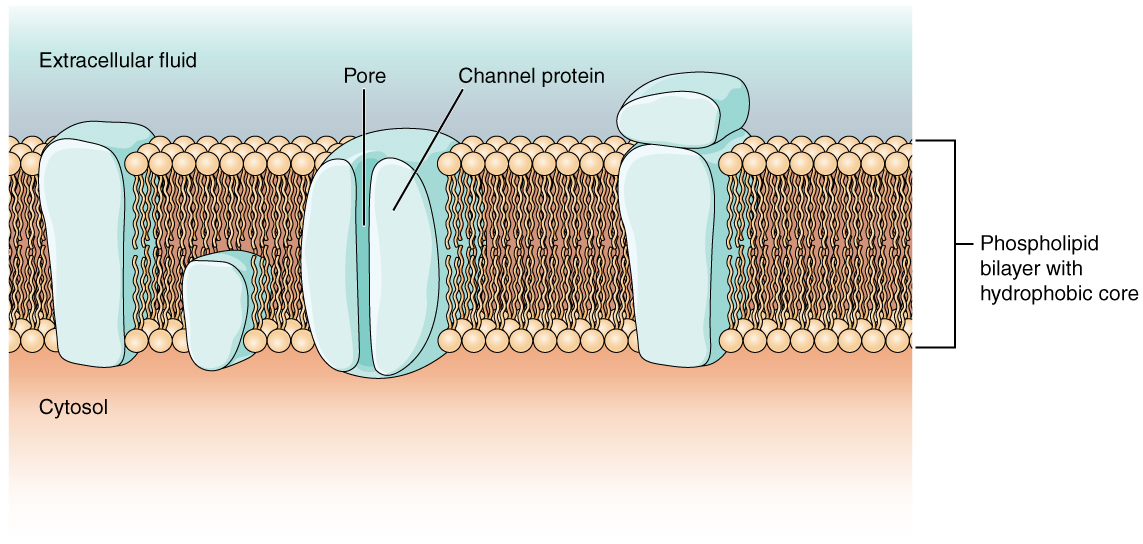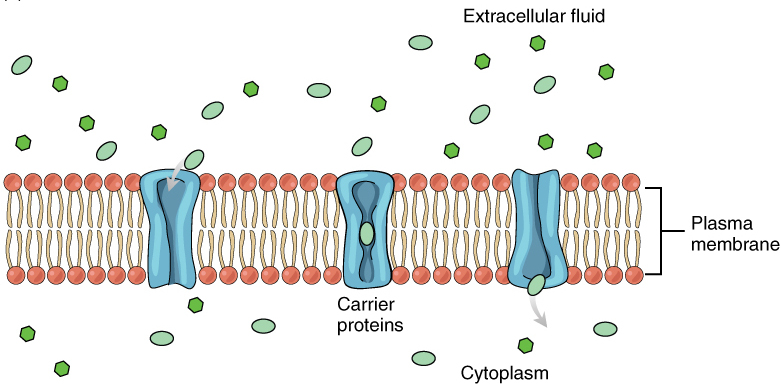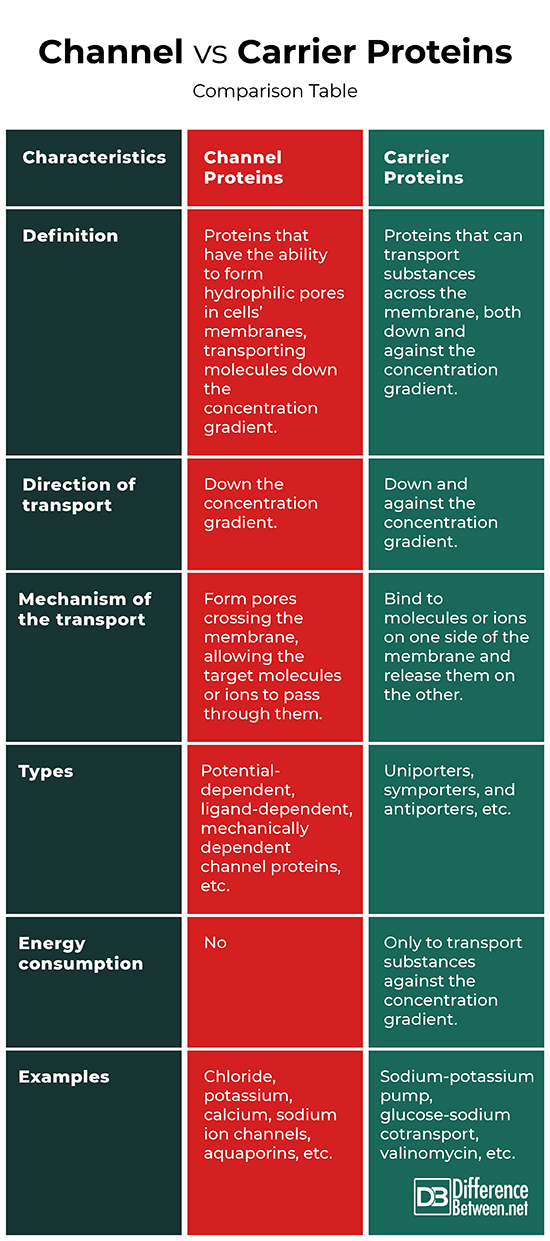Difference Between Channel and Carrier Proteins
The cell membrane separates the cell from the external environment. It is a semipermeable lipid-protein coat existing in all cell types. The cell membrane contains membrane proteins, providing selective permeability and membrane transport. These proteins are important to sustaining life, as a cell’s survival depends on its ability to control the different composition of the extracellular and intracellular environment. Transport proteins, part of the membranes are channel and carrier proteins.

What is Channel Proteins?
Channel proteins are proteins that have the ability to form hydrophilic pores (channels) in cells’ membranes, transporting molecules down the concentration gradient.
Channel proteins allow the transport across the membrane either of one type of molecule or of several types of similar molecules. They have different diameters, electrically charged groups, and high selectivity. Channel proteins cross the entire membrane, thus allowing the target molecules to pass through them by diffusion. This transport allows polar and charged substances to avoid the hydrophobic interior part of the membrane, which would slow down or block their entry into the cell.
Channel proteins do not interact with the transported substances. This allows the fast transport of the substances through the membrane.
Some channel proteins are open all the time, others can be opened or closed in response to a specific signal (such as an electrical signal or the binding of a molecule). Cells involved in the transmission of electrical signals (nerve and muscle cells) have closed channel proteins for sodium, potassium, and calcium ions in their membranes. The opening and closing of these channels, as well as the resulting changes in the concentration of these ions inside the cell, play an important role in electrical transmission across membranes in nerve cells and in muscle contraction.
Depending on the factor that opens (activates) or closes (inactivates) the channel proteins they are:
- Potential-dependent channel proteins – activated by a change in the membrane potential;
- Ligand-dependent channel proteins – activated by binding to a ligand-mediator, hormone;
- Mechanically dependent channel proteins – activated by mechanical deformation of the cell membrane.
Examples of channel proteins include chloride, potassium, calcium, sodium ion channels. A specific type of channel proteins are aquaporins, which can conduct water through the membrane very quickly.

What is Carrier Proteins?
Carrier proteins are integral proteins that can transport substances across the membrane, both in the direction of and against the concentration gradient.
Carrier proteins are divided into:
- Uniporters – carry only one type of molecules or ions, against the concentration gradient;
- Symporters – carry two or more different molecules or ions in one direction;
- Antiporters – carry to opposite directions different molecules or ions.
Carrier Proteins transport substances through the cell membranes against (active transport) or down the concentration gradient (facilitated diffusion). Moving substances against the concentration gradient requires energy. This energy may be obtained from ATP or from the environment. The transport of molecules and ions down the concentration gradient does not require energy.
Some proteins execute the so-called secondary active transport, which uses facilitated diffusion of one substance to drive the active transport of another. This transport requires energy, but it is not obtained directly from ATP.
The functions of the carrier proteins include:
- Transporting large molecules through the cell membrane (lipids, sugars, etc.);
- Creating ion gradients, allowing:
- Functioning of the mitochondria – the transport of protons through the membrane and the resulting gradient leads to the creation of ATP;
- Functioning of the nerve cells – the sodium-potassium gradient is the power source of these cells;
- Functioning of chloroplasts, etc.
Examples of carrier proteins are:
- Sodium-potassium pump – uses 20-25% of the ATP in the human cells to transport sodium and potassium ions outside the cell, against the gradient;
- Glucose-sodium cotransport – indirectly uses ATP to power secondary active transport;
- Valinomycin – carries potassium down the concentration gradient. It can destroy bacteria’s electrochemical gradients and is used as an antibiotic.
Difference Between Channel and Carrier Proteins
Definition
Channel Proteins: Channel proteins are proteins that have the ability to form hydrophilic pores in cells’ membranes, transporting molecules down the concentration gradient.
Carrier Proteins: Carrier proteins are integral proteins that can transport substances across the membrane, both down and against the concentration gradient.
Direction of transport
Channel Proteins: Channel proteins transport substances down the concentration gradient.
Carrier Proteins: Carrier proteins transport substances both down and against the concentration gradient.
Mechanism of the transport
Channel Proteins: Channel proteins form pores crossing the membrane, thus allowing the target molecules or ions to pass through them by diffusion, without interaction.
Carrier Proteins: Carrier proteins bind to molecules or ions on one side of the membrane and release them on the other.
Types
Channel Proteins: Depending on the factor that activates or inactivates them, the channel proteins arepotential-dependent, ligand-dependent, mechanically dependent channel proteins, etc.
Carrier Proteins: Depending on the characteristic of the transport carrier proteins are uniporters, symporters, antiporters, etc .
Energy consumption
Channel Proteins: Channel proteins do not consume energy to transport molecules and ions down the concentration gradient.
Carrier Proteins: Carrier proteins need energy to transport substances against the concentration gradient. The transport of molecules and ions down the concentration gradient does not require energy.
Examples
Channel Proteins: Examples of channel proteins include chloride, potassium, calcium, sodium ion channels, aquaporins, etc.
Carrier Proteins: Examples of carrier proteins are sodium-potassium pump, glucose-sodium cotransport, valinomycin, etc.
Channel VS Carrier Proteins: Comparison table

Summary:
- The cell membrane contains membrane proteins, providing selective permeability and membrane transport. Transport proteins, part of the membranes are channel and carrier proteins.
- Channel proteins are proteins that have the ability to form hydrophilic pores in cells’ membranes, transporting molecules down the concentration gradient.
- Carrier proteins are integral proteins that can transport substances across the membrane, both down and against the concentration gradient.
- Channel proteins transport substances down the concentration gradient, while carrier proteins transport substances both down and against the concentration gradient.
- Channel proteins form pores crossing the membrane, thus allowing the target molecules or ions to pass through them by diffusion, without interaction. Carrier proteins bind to molecules or ions on one side of the membrane and release them on the other.
- Depending on the factor that activates or inactivates them, the channel proteins are potential-dependent, ligand-dependent, mechanically dependent channel proteins, etc. Depending on the characteristic of the transport carrier proteins are uniporters, symporters, antiporters, etc.
- The transport of molecules and ions down the concentration gradient does not require energy. Channel proteins do not consume energy, carrier proteins need energy only to transport substances against the concentration gradient.
- Examples of channel proteins include chloride, potassium, calcium, sodium ion channels, aquaporins, etc. Examples of carrier proteins are sodium-potassium pump, glucose-sodium cotransport, valinomycin, etc.
- Difference Between Gallstones and Cholecystitis - September 5, 2021
- Difference Between Constipation and Cramping - August 4, 2021
- Difference Between Whole Genome Sequencing and Microarray - May 6, 2021
Search DifferenceBetween.net :
2 Comments
Leave a Response
References :
[0]Cibas, E., B. Ducatman. Cytology. 4th Edition. Authors: Philadelphia: Elsevier Saunders. 2014. Print.
[1]McKee, T., J. McKee. Biochemistry: The Molecular Basis of Life 6th Edition. Oxford: Oxford University Press. 2015. Print.
[2]Moore, J., R. Langley. Biochemistry for Dummies 2nd Edition. Hoboken: Wiley Publishing Inc. Print.
[3]Image credit: https://commons.wikimedia.org/wiki/File:1215_Cell_Membrane_Channels.jpg
[4]Image credit: https://commons.wikimedia.org/wiki/File:0306_Facilitated_Diffusion_Carrier_Protein.jpg

Great descriptions!
Can I use the information above for instagram post with your mention